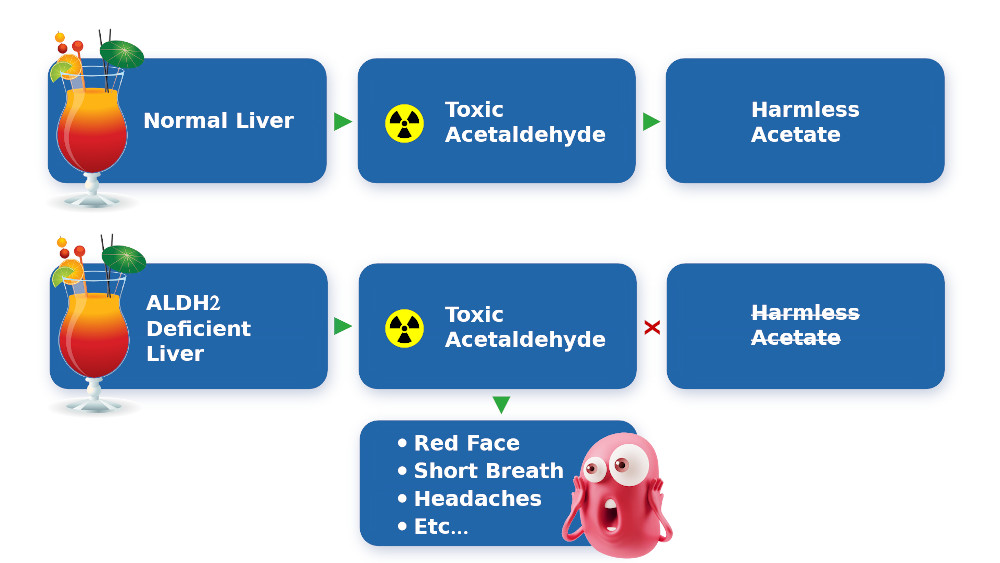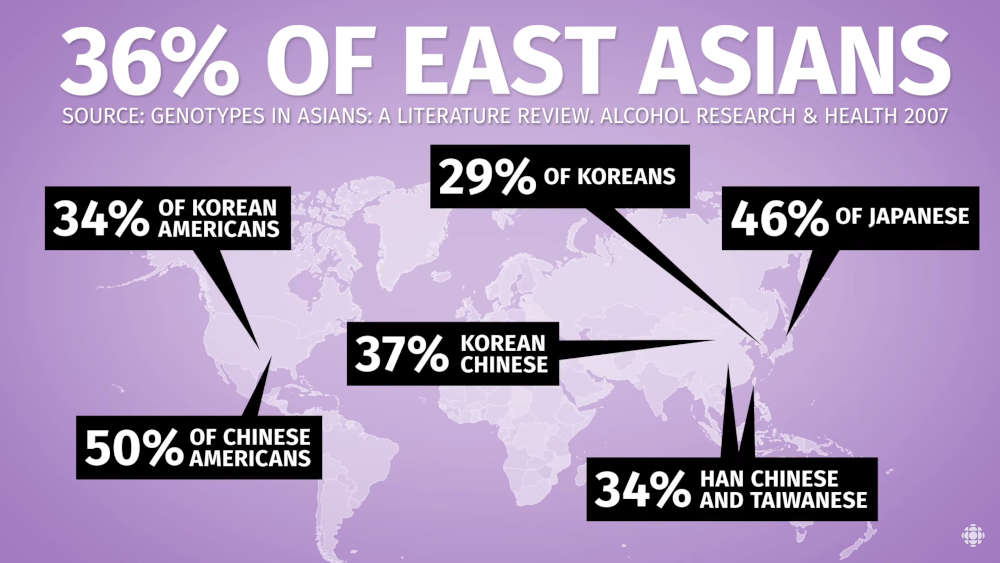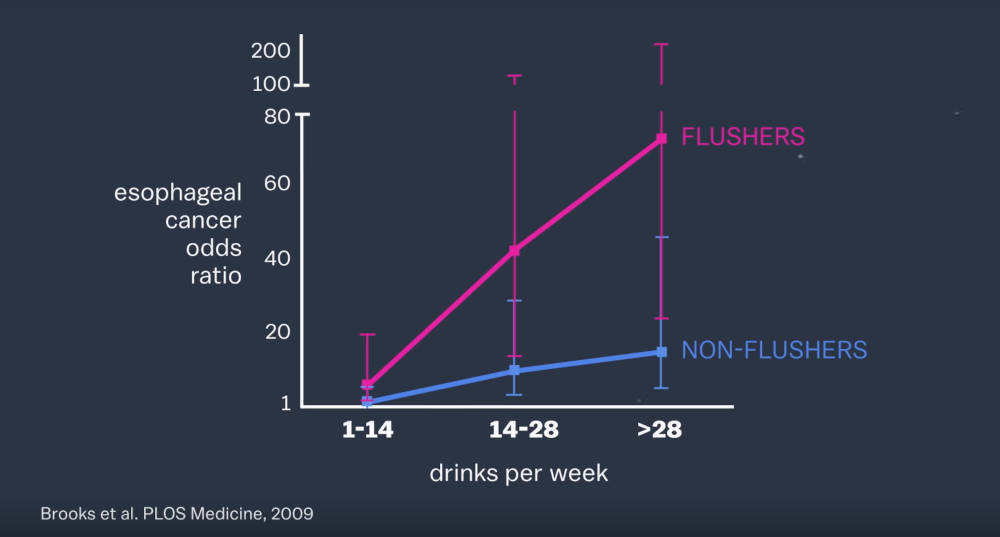
Table of Contents
- Introduction
- What is Asian Flush?
- Symptoms of Asian Flush
- Who is Affected?
- Is it an Alcohol Allergy?
- Asian Flush Health Risks
- Dangers of Self-Treatment
- How to Safely Control Symptoms
- Social Challenges
Introduction
Asian flush, or Alcohol flush reaction, refers to when the face turns red after consuming alcohol. The redness usually starts around the eyes and cheeks and can spread to the whole face and upper body depending on its severity.
Aside from the red face, other Asian flush symptoms include red eyes, hot flushes, headaches, restricted breathing and rapid heartbeat.
Alcohol flushing is sometimes called ‘Asian flush’ because it happens to a large proportion of the Asian population. According to Dr Lei Yu, a distinguished professor from the Department of Genetics at Rutgers Center of Alcohol & Substance Use Studies, approximately 50% of Asian people experience flushing from alcohol. Despite being common amongst Asians, flushing from alcohol can also affect about 3-29% of non-Asian people too.
The medical community generally recognises Asian flush as a genetic intolerance to alcohol. Whilst not an allergy to alcohol per se, a lot of the symptoms are similar to typical allergy symptoms.
Most doctors will advise sufferers of Asian flush that there is no treatment for the red flushing after consuming alcohol. That said, many people commonly engage in the dangerous off-label use of antihistamine medications to reduce their Asian flush symptoms.
The biggest danger with self-treating Asian flush symptoms is that it ignores some very serious health risks common in people who flush red from alcohol.
Aside from the unpleasant physical symptoms and longer-term health risks, Australians with Asian flush also face deeper psychological challenges socialising and fitting into a culture that embraces alcohol consumption.
The purpose of this article is to broaden awareness of Asian flush and educate Australians about what it is, how it happens and what can be done about it.
What is Asian Flush?
Asian flush commonly describes when someone gets a red face after drinking alcohol. This happens because of a complex chain reaction of events:
When alcohol enters the body, it makes its way to the liver to get metabolised. The liver then breaks down alcohol in 2 main stages.
“Alcohol gets broken down in two steps by our liver — first from ethanol to acetaldehyde, and then from acetaldehyde to acetate. Essentially, it goes from alcohol to vinegar”
Dr Terry Mulhern, Director of Teaching and Learning at in the School of Biomedical Sciences at the University of Melbourne,
People with Asian flush don’t have the right enzymes for this second stage of metabolism. They have what geneticists refer to as ALDH2 deficiency. This means that the alcohol just gets broken down into the toxin called acetaldehyde and stays in the body in that form.

“Acetaldehyde is a highly toxic substance and essentially gives that redness pigmentation, that flush, and that’s really a sign the person needs to stop drinking and hydrate.”
Dr Brad Broughton, Senior member within the Vascular Biology and Immunopharmacology Group in the Department of Pharmacology at Monash University.
Eventually, this toxin makes its way throughout the body and causes it to start releasing histamines. These histamines cause the blood vessels under the skin of the face to dilate and let more blood flow through. This is why the vessels under the skin look redder and end up causing a flushed look on the face and upper body.
The red face isn’t the only symptom of Asian flush. Other symptoms can often take the form of allergy-like symptoms such as rapid heart rate, difficulty breathing, rashes, hives, red eyes, etc.
“It’s not an allergic reaction, but it causes a downstream effect like an allergic reaction, like flushing, sweating and red face.”
Dr Terry Mulhern, Director of Teaching and Learning at in the School of Biomedical Sciences at the University of Melbourne.
Symptoms of Asian Flush
Asian flush symptoms can vary in severity from person to person and will often include one or more of the following:
- Facial flushing
- Neck and upper body flushing
- Swelling around the eyes and cheeks
- Slight breathing difficulties
- Rapid heart rate
- Headache
- Bloodshot eyes

The amount of alcohol needed to trigger these symptoms also varies from person to person. In general, symptoms will occur after anywhere between 0.5 to 2 standard drinks. If any of the above symptoms happen after only a tiny sip of beer or wine, it might be a good idea to consult with an allergy specialist about a possible alcohol allergy.
The first signs of Asian flush symptoms will start about 20 minutes after drinking a sufficient amount of alcohol.
The order of the symptoms will vary from person to person. Many people report first experiencing slight shortness of breath and numbness or tightness on the cheeks or forehead.
This numbness sensation then progresses to facial and upper body flushing and red bloodshot eyes. Depending on the quantity of alcohol consumed, the flushing stage is then followed by a rapid heartbeat and a pounding migraine-like headache.
Other alcohol-related symptoms like dizziness and nausea can also accompany the Asian flush symptoms depending on the quantity of alcohol consumed.
Many Australians with Asian flush report that their negative symptoms far outweigh the positive effects of consuming alcohol. An overwhelming number also report feelings of embarrassment when dealing with their symptoms in a public place. These two factors often cause many Australians with Asian flush to stop drinking alcohol altogether.
Some doctors prescribe patients with alcoholism a drug called Disulfiram. The purpose of Disulfiram is to essentially simulate Asian flush in people with alcoholism to discourage them from drinking alcohol. Unsurprisingly, Australians with Asian flush have to been shown to be less likely to suffer from alcoholism compared to normal alcohol drinkers.
Who is Affected?
Anyone can have the alcohol flush reaction. The reason it is commonly called ‘Asian flush’ is that a large proportion of Asian people are affected.

Approximately 36% of East Asian people lack a properly functioning ALDH2 enzyme and therefore suffer from alcohol flushing. A large proportion of people of Middle Eastern and Indian descent are also affected.
Between 3-29% of non-Asian Australians also lack a functioning ALDH2 enzyme and report various symptoms of the alcohol flush reaction.
The reason for the increased prevalence amongst Asian people has been hypothesised to have links to rice domestication in Asia between 7,000 and 10,000 years ago.
Is it an Alcohol Allergy?
Asian flush is not the same as an alcohol allergy. Both share some similarities in their symptoms, but should not be confused.
An alcohol allergy can happen from the tiniest exposure to alcohol and can sometimes result in unconsciousness or even death.
On the other hand, a tiny drop of alcohol will not be enough to trigger any of the symptoms of Asian flush.
Distinguishing between the two may be the difference between needing to avoid alcohol altogether or merely reducing intake and trying to control symptoms.
An allergy to alcohol is actually quite rare. Many Australians who think they are allergic to alcohol might actually have an intolerance to an ingredient used in the production of the alcohol.
This kind of alcohol intolerance can be managed by careful drink selection. For example, many Australians are sensitive to sulphites and tannins that are often found in alcohol. Choosing low sulphite and low tannin varieties of alcohol might benefit these particular people.
Asian Flush Health Risks
It is common to only associate Asian flush with the short-term symptoms discussed above. The reality is that there are many other longer-term health implications facing Australians who flush red when they drink alcohol.
Here are some of the longer-term health implications for Australians with Asian flush who drink alcohol on a regular basis:
- Increased risk of upper digestive tract cancer
- Increased DNA damage
This is not an exhaustive list but includes the two key risks facing Asian flush sufferers that were identified by the United States National Institutes of Health (NIH) and the International Agency for Research on Cancer (IARC).
Both of these prominent institutions have issued warnings for people with Asian flush to refrain from drinking alcohol. In particular, they both identify the culprit of the longer-term health risks to be the metabolic toxin acetaldehyde.

As mentioned above, acetaldehyde is produced when the body tries to break-down alcohol. The liver usually breaks down this toxin into a harmless substance, but people with Asian flush lack the proper enzymes to do this. Therefore, the toxin accumulates in the body and causes the above health risks.
This inability to properly break down acetaldehyde can also increase the risks of the drinker to the various risks of alcohol consumption in general:
“Those who have the condition but still drink heavily may be more vulnerable to health risks imposed by their alcohol consumption.”
Dr James Marshall, Professor from the Department of Epidemiology and Environmental Health at University at Buffalo.
Despite warnings from these international agencies, most Australians with Asian flush are unaware of these longer-term health implications. Many continue to drink alcohol and even dangerously try to mask their symptoms with antihistamines.
Dangers of Self-Treatment
Self-treating any kind of health problem is inherently risky. A general practitioner is the best point of call for all Australians looking to do something about their alcohol flushing symptoms.
Unfortunately, many Australians are told by their general practitioners that there is nothing they can do about alcohol flushing other than to stop drinking alcohol.
However, with the ever-present social pressure to consume alcohol, many Australians are turning to dangerous off-label use of antihistamine medications to reduce their Asian flush symptoms.
The go-to antihistamine for Australian Asian flush sufferers is Zantac. Usually used to calm stomach acid reflux, the off-label use of histamine-2 blocking antihistamines like Zantac reportedly has a noticeable effect on Asian flush symptoms.
This off-label use is particularly dangerous in light of the above discussion about the long term health risks facing Australians with Asian flush. This is because, whilst the antihistamine properties of Zantac might reduce the outward signs of alcohol flush reaction, it does not reduce the amount of toxic acetaldehyde that accumulates in the body.
“Using histamine-2 blockers to reduce the ‘Asian flush’ can escalate alcohol intake and increase the risk of stomach cancers, oesophagal cancer and a type of skin cancer called squamous cell carcinoma… The use of H2 blockers may allow someone suffering from Asian glow to drink higher levels of alcohol, but this person shouldn’t do that. It’s just not smart. ”
Dr Daryl L Davies, Professor of Clinical Pharmacy at USC School of Pharmacy.
Therefore, Australians who take Zantac to reduce their Asian flush symptoms might feel like they can drink more alcohol, but are actually putting more dangerous toxins into their body and increasing their risks of various cancers.
How to Safely Control Symptoms
There are much safer ways to control Asian flush symptoms than the off-label use of antihistamines. As mentioned above, these drugs are not intended to be used for Asian flush.
Some of these methods include:
- Drinking less
- Choosing the right alcohol
- The pre-drink
- Supplements
The severity of Asian flush has a lot to do with how quickly alcohol is consumed. This is because it depends on how much alcohol the body must metabolise at any given time. By reducing your alcohol intake, and finding the optimal rate of consumption, you can continue to consume alcohol slowly without flushing red in the face.
The type of alcohol consumed is also very important. Drinks like beer and wine often contain ingredients and other chemicals that can make flushing worse. Knowing which drinks are safe and which are not is a great way to get control of alcohol flushing and enjoy alcohol without unnecessary redness.
A pre-drink technique is sometimes used by people to prepare themselves for a night of drinking. It is said that if a pre-drink is consumed before going out, the chance of flushing red from any additional drinks is much less.
Finally, some supplements and compounds have been shown to aid the body’s ability to break down the toxin that causes alcohol flushing. The main benefit of this approach is that, unlike antihistamines that simply reduce symptoms, these supplements go to the root cause of alcohol flushing. By reducing the toxin acetaldehyde, the supplements may not only reduce the flushing reaction but also reduce the toxin behind many of the longer-term health risks associated with Asian flush.
We cover all of these methods in more detail in our article titled: DIY Asian Flush Cures.
Social Challenges
Up until now, we’ve focused on the physical aspects of Asian flush. However, a topic rarely spoken about is the challenges often facing Australians who have to deal with the social impact of alcohol flushing.
Australia has a culture that embraces alcohol. For celebration, socialising or just a couple of cold beers at the cricket, the consumption of alcohol often goes hand in hand with having a good time.
Australians battling with Asian flush often report feeling left out and unable to participate in the fun. Sometimes this can also involve a social pressure to drink alcohol in order to fit in and not be the only one not “getting on it”.
Not all Australians abstain from drinking alcohol. Some choose to continue drinking and put up with their uncomfortable symptoms and embarrassing red face.
“This is their body telling them to stop drinking immediately. I know it’s frustrating for people because it may be challenging being surrounded by people who drink often.”
Dr Sean Patrick Nordt, Chief Medical Officer and the Gavin Herbert Endowed Professor of Pharmacy at the Chapman University School of Pharmacy.
Many non-flushing Australians are not aware of what alcohol flush reaction is. When they see someone flushing red from alcohol, the typical reaction is to think that something is wrong with them or that they are totally drunk.
In contrast to this, in Asian countries such as China and Japan where alcohol flushing is common, flushing red from alcohol is a sign that a person is having a good time.
“Many believe this to be a sign of good “qi” when in fact, it indicates that the person may have trouble metabolising alcohol and this exposes them to a higher risk of certain diseases and cancers.”
Dr Tan Ek Khoon, Associate Consultant from the Department of Hepato-pancreato-biliary and Transplant Surgery at Singapore General Hospital.
The purpose of this blog is to educate both flushing and non-flushing Australians about Asian flush. Our aim is to broaden the awareness of Asian flush in Australian society and empower sufferers of alcohol flushing with the knowledge required to enjoy alcohol with confidence and live a full, fun and satisfying social life.


Leave a Reply